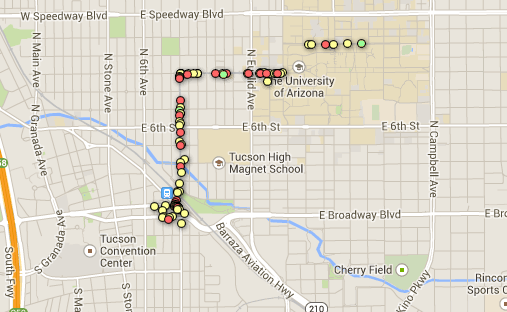 After almost 18 months and 86 streetcar crash reports, Living Street Alliance released the data they collected using their crash reporting tool.
After almost 18 months and 86 streetcar crash reports, Living Street Alliance released the data they collected using their crash reporting tool.
Before diving into the results, it’s important to recognize that it is extremely likely that the number is only a fraction of the actual crashes that occur along the streetcar route. Many of the people who crash because of the streetcar route likely don’t know about the reporting tool or even the the advocacy organization.
That being said there are some interesting results gleaned from the data.
Here’s what Living Street Alliance said about the data they released:
After 18+ months of collecting crash reports (August 2012 to April 2014), we’ve decided it’s time to share the results of the reports we’ve collected so far using our Streetcar Track Crash Reporting tool. We went through all the reports we received and removed any duplicates we found, removed any reports that occurred on the older trolley tracks, and generally cleaned them up. The data we’re releasing has been stripped of any identifying information. Bear in mind that unless an accident involves a motor vehicle, there is no police record and no data about the crash; we’re collecting this data to make sure that safety can be improved for all road users in an evidence-based way.
Here are some of the interesting results:
• 69 percent of the people who crashed had more than 3 years of riding experience.
It may be artificially high because it’s more likely that more experienced cyclists are plugged into the bike community and know about the reporting tool. But it also shows that even people who have experience can go down.
• 30 percent of the crashes resulted in “serious” injuries and 66 percent reported minor injuries.
• 58 percent of the crashes appeared to occur because of an outside force beyond rider error.
• 27 percent of the crashes occurred because of something blocking the bike lane including cars and people.
• Main Gate and the Fourth/Toole/Congress Avenue intersection generated the highest number of crash reports.
Check out the data and maps over on the Living Streets Alliance website. Does anything pop out to you?

“58 percent of the crashes appeared to occur because of an outside force beyond rider error.”
What is an example of this? Is being forced out of the bike lane and failing to negotiate the tracks in this category?
I’m sure that there are many contributing factors to crashes, but I’d be very surprised if the vast majority of all street car related incidents are ultimately caused by an error of the bicycle operator.
86 cyclists who won’t crash on the tracks again. My guess is that 95% of crashes can be avoided by going slower and more carefully. Of course, that won’t change how I ride 🙂
I had an unreported crash on 4th just south of University a couple of months ago. I have decades of experience riding on the street with tens of thousands of miles under my belt. I am very aware of the street car tracks and the need to cross at an oblique angle. Even so, stuff happens. In my case, a city truck merged out from the curb right in front of me causing me to swerve. The tracks meander across 4th at the location due to the curve of the tracks for the turn from University. The combination of circumstances caught me in a bad position. I might have muscled my way across the tracks, but the bike I was riding had an old fashioned threaded headset stem, so it twisted in the fork and my wheel could not turn out of the slot to get over the tracks. Splat, I went. Now I know why mountain bikes have threadless headsets and sturdy clamps on the stems.
The point is that there are likely many crashes like mine that go unreported and involve an experienced and aware cyclist. In my mind, it is naive to think that the hazard caused by the tracks can be dismissed so easily by some – usually someone that is not experienced with the multiple hazards of the road that cyclists face. I’m sure that some think the problem can be addressed by education and a few safety tips. Sure, that is helpful, but the issue is not that simple.
[…] here to read the full […]